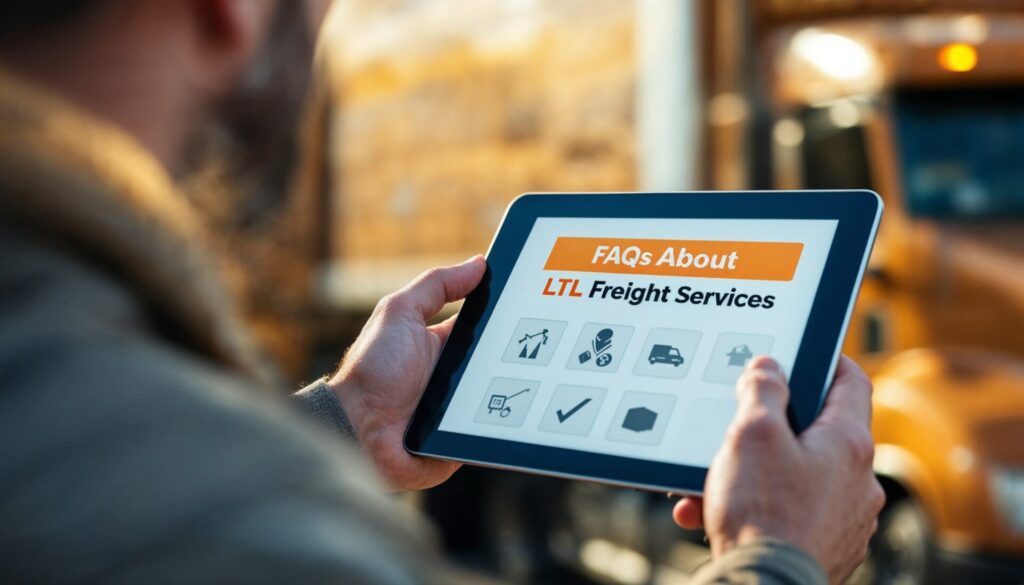
FAQs About LTL Freight Services
Less Than Truckload (LTL) shipping bridges the gap for businesses that don’t need a full trailer for their goods. It’s a practical option when you’re looking to move smaller volumes but still require timely, efficient transport. However, navigating the specifics can be confusing—especially with so many questions about rates, packaging, and freight classes.
In this comprehensive FAQ guide, we address the most common queries shippers have about LTL services, helping you streamline your logistics strategy. Whether you’re shipping a few pallets a month or regularly sending partial loads across the country, these answers will help you plan your shipments, avoid hidden fees, and choose the right carrier or broker for the job.
Introduction
LTL shipping stands out because it allows multiple customers to share space on one truck, dividing the costs. This model makes it more cost-effective than booking a Full Truckload (FTL) when your freight volume doesn’t justify an entire trailer. Yet, it also introduces additional complexity: handling, multiple loading/unloading points, and the possibility of damage or delays if your cargo isn’t properly prepared or classified.
The following sections delve into the key questions and concerns surrounding LTL freight, equipping you to make more informed decisions and optimize your supply chain.
FAQ #1 – What Is LTL Freight?
LTL stands for “Less Than Truckload,” which means you’re shipping a load that doesn’t occupy the entire space of a trailer. Instead, your cargo shares space with other shipments heading in the same general direction. Carriers charge you only for the portion of the trailer your freight occupies. This method is cost-effective for shipping smaller loads—typically ranging from a few hundred to around 10,000–15,000 pounds.
FAQ #2 – How Does LTL Differ from FTL?
- FTL (Full Truckload): You rent the entire trailer for exclusive use. This is ideal for large, time-sensitive, or high-value freight needing minimal stops.
- LTL (Less Than Truckload): Multiple smaller shipments share a single truck. Each shipper pays only for the space used. While cost-effective for smaller loads, it often has longer transit times and more handling points compared to FTL.
FAQ #3 – Is LTL More Expensive Per Pound Than FTL?
Often, yes. Because the carrier has to handle multiple shipments and coordinate various pickups and drop-offs, the per-pound cost can be higher than in FTL. However, if you don’t need the full trailer space, paying only for a portion is generally cheaper overall than booking an entire truck you won’t fully utilize.
FAQ #4 – What Commodities Can I Ship via LTL?
Most non-hazardous and properly packaged goods—ranging from consumer electronics to industrial components—can move via LTL. Some carriers handle hazmat loads or temperature-controlled shipments, but you’ll need to confirm they have the right equipment and certifications. Always check each carrier’s restrictions, as certain items (e.g., live animals, extremely fragile materials) may require specialized services or might not be accepted at all.

FAQ #5 – How Do I Calculate an LTL Rate?
LTL rates typically depend on:
- Freight Class: Determined by density, stowability, handling, and liability.
- Weight: Prices usually break at certain weight thresholds (e.g., minimum charges for very light shipments).
- Distance: The pickup and delivery zip codes or region.
- Additional Services: Accessorial fees (e.g., liftgate, inside delivery, limited access) raise costs.
You can request a rate quote from carriers or brokers by providing accurate shipment details—weight, dimensions, NMFC code, origin, and destination.
FAQ #6 – Do I Need a Pallet for LTL Shipments?
It’s strongly recommended. Palletizing your shipment enhances stability, handling, and safety, reducing damage risks. While you can technically ship certain items unpalletized, many carriers either insist on palletizing or charge extra for floor-loaded or loose freight. Properly secured and labeled pallets streamline cross-dock handling and minimize reclassification issues.
FAQ #7 – How Is Freight Class Determined?
Freight class, managed by the National Motor Freight Classification (NMFC) system, is influenced by:
- Density: Weight relative to space occupied.
- Stowability: Can it be stacked or easily stored?
- Handling: Fragile or special handling needs increase the class.
- Liability: High-value or easily damaged items often sit in higher classes.
If your declared class is inaccurate, carriers may reclassify mid-transit and impose additional charges.
FAQ #8 – How Do I Handle LTL Shipment Documentation?
Accurate Bill of Lading (BOL) is crucial. It should list:
- Shipper and Consignee Info
- Freight Class and NMFC Code
- Weight, Dimensions, and Packaging Type
- Special Services: Noting if you need a liftgate, appointment, or inside delivery.
You may also need a commercial invoice for cross-border shipments or other specialized docs (e.g., hazmat, certificates of origin).
FAQ #9 – What Are Accessorial Fees in LTL?
These are extra charges for services beyond standard dock-to-dock shipping. Common examples:
- Liftgate: If the facility lacks a loading dock.
- Inside Delivery: Bringing freight beyond the threshold.
- Limited Access: Schools, military bases, or remote locations.
- Appointment: If the receiver requires a set delivery time or call-ahead service.
Understanding your exact needs avoids surprise fees.
FAQ #10 – How Can I Track My LTL Freight?
Most carriers offer online portals or tracking tools where you enter a PRO number (carrier’s tracking ID) or BOL reference. Some brokers consolidate multiple carriers’ updates into one interface, easing your job if you ship with multiple providers. Track your shipment’s movement from pickup to final destination; schedule email or text alerts for milestone updates.

FAQ #11 – What If My Freight Gets Damaged in Transit?
File a claim with the carrier or coordinate through your broker if damage or loss occurs. The process typically involves:
- Noting Damage: Mark it on the delivery receipt upon arrival.
- Providing Proof: Pictures, weigh tickets, and thorough descriptions.
- Awaiting Carrier Investigation: They’ll review packaging, BOL notes, and condition details.
To minimize damage risk, invest in sturdy packaging and label items with “Fragile” or “This Side Up” where necessary.
FAQ #12 – How Do I Manage Multiple LTL Shipments?
If you regularly send out multiple smaller loads:
- Centralize Your Booking: A TMS (Transportation Management System) or broker can unify quotes and track shipments in one place.
- Consolidate Where Possible: Combining shipments to the same region might yield discounts or partial truckload rates.
- Set Cutoff Schedules: Align production and order timelines so multiple shipments can move together.
FAQ #13 – Can I Consolidate LTL Freight for Better Rates?
Yes. Known as pool distribution or consolidation, you combine partial loads heading to a similar region. This can lower costs, reduce handling, and speed deliveries if effectively planned. 3PLs or brokers often facilitate consolidation by matching multiple shippers’ freight in a single route.
FAQ #14 – Are There Special Requirements for Cross-Border LTL?
Absolutely. International shipments (e.g., U.S. to Canada, Mexico, or overseas) may need:
- Commercial Invoices: Detailing product value and origin.
- Customs Broker: To handle duties, tariffs, and clearance.
- Cross-Border Carriers: They must be familiar with local regulations and comply with each country’s laws.
Plan for extra transit time, especially if customs inspections occur.
FAQ #15 – How Do I Choose the Right LTL Carrier or Broker?
Focus on:
- Coverage and Specialization: If you need regional deliveries or specialized equipment (refrigerated, hazmat), pick carriers proficient in that area.
- Reliability: Look for on-time performance stats and lower damage rates.
- Support and Communication: Timely updates, a dedicated rep, or easy access to real-time tracking.
- Price vs. Value: The cheapest option might have hidden fees or slow transit. Evaluate the overall service package.
Conclusion
LTL freight shipping can be a game-changer for businesses needing flexible, cost-efficient transport. By sharing trailer space with other shippers, you avoid paying for unused capacity. However, success hinges on accurate freight classification, thoughtful packaging, and understanding potential fees like liftgate or inside delivery charges.
Armed with these frequently asked questions, you can better navigate the complexities of LTL freight, from picking the right carrier or broker to handling paperwork and damage claims. Whether you’re dipping your toes into partial-load shipping or scaling up an existing logistics operation, mastering these fundamentals sets the stage for smoother, more profitable freight moves.
How useful was this post?
Click on a star to rate it!
Average rating 0 / 5. Vote count: 0
No votes so far! Be the first to rate this post.



